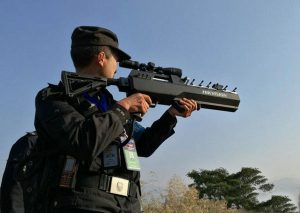The drone industry is currently growing exponentially and shows no signs of slowing down. Although this is a good thing for all related industries that benefit from drones, new technologies always bring unexpected challenges and regulatory requirements.
One of the real biggest challenges is how to prevent drones from entering restricted airspace.
The Federal Aviation Administration (FAA) has done an excellent job of fast action to ensure that long-range pilots and the general public adapt to the development stage we are currently going through. Needless to say, despite everyone’s best efforts, the introduction of drones into commercial airspace has not been smooth sailing.
Whether intentional or naive, there have been enough illegal incidents that require counter-attack technology to keep drones away from areas where safety is a top priority.
In this article, we will discuss the purpose of drone jammer, where they are used, and whether you should worry about encountering such interference.
What is a drone jammer?
Unfortunately, the drone jammer is not the drone you put on before you put the drone into the bed (maybe a friend of the day). It also has no maliciousness as its name suggests, it will not freeze your props or crash your drone into the ground during flight (of course it is legal).
In short, a drone jammer is a machine designed to send electromagnetic noise at radio frequencies in order to cancel the same radio and GPS signals that the drone uses to operate. The frequency of drone jammers is usually assigned to 2.4 GHz or 5.8 GHz, which are public frequencies that are not assigned to manned aircraft, public broadcasting, or cell phone signals.
They usually look a lot like guns and can work by projecting interference signals into a cone shape of about 15-30 degrees. When the drone is hit by a jammer’s signal, the most common response is to return the drone to its origin (unless the GPS is also blocked) so that the jammer operator can follow the drone to the pilot. In other cases, the drone jammer may land the drone on the scene for forensic investigation.

Robust drone jammers on the market can operate at the farthest point and become more effective as the pilot’s remote control moves away from the drone. For pilots and control agencies, this technology is actually a win-win solution, because the risk it brings is much lower than other UAV countermeasures, and in most cases, the pilot’s UAV is not Will be hurt.
Alternative strategy
Radio signal interference from drones is the preferred and safest method to control unauthorized drones. However, since not all drones are purchased and built through DJI or other commercial manufacturers, there is still room for more physical measurements if the drone jammer cannot complete the mission. Other indicators used include:
UAV Net-If the UAV violates the jamming signal, depending on the situation, a larger UAV carrying net can be deployed to physically capture the unauthorized UAV and drive it out of the sky. In this case, the drone is more likely to fall from the sky, and the pilot is less likely to retrieve it completely. Shooting drones-During the 2018 South Korean Olympics, if the situation worsens, security personnel can shoot rogue drones from the air using the cUAS protocol. Fortunately, this is not required. On the contrary, people will always remember the incredible synchronized drone performance Intel provides. Watch the video!
Where is the drone jammer used?
Since drone interference is legally limited to the federal government, current applications of this technology are limited to high-level activities and operations directly related to the Secret Service and the military. One of the first public statements on signal interference and government safety was issued after a drone crashed into the White House lawn in 2015.
An official from the CIA spoke to the Associated Press to understand why they missed the drone and how to immediately step up their efforts to further ensure the safety of the White House through signal scrambling. If you don’t know much about the specific technologies and protocols involved in interfering with drones, it’s because the federal government is trying to prevent the commercial use of drones by developing its own technology and ensuring safety by enacting specific legislation.
As the saying goes, no matter what technology ordinary consumers use and sell, it may lag behind the development of the military and the government by ten years or more. Without over-considering the philosophy of this statement, it is currently very clear that our government is busy developing drone jamming technology that will protect our skies from ordinary commercial long-range pilots and pilots with this ability. s attack. ‘Intention to cause damage.